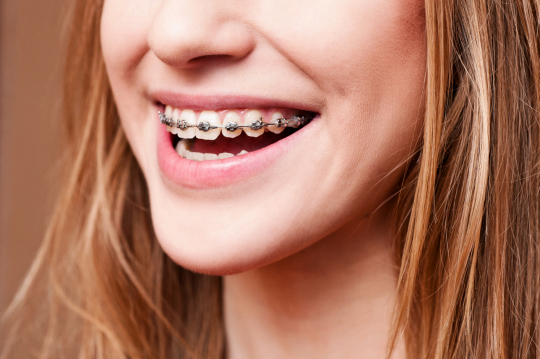Braces are a well-known and widely used orthodontic treatment, but have you ever wondered how exactly they work? Many people know that braces help straighten teeth, but the process involves more than simply applying pressure to move teeth into alignment. Understanding the science behind braces can help you better appreciate how they work and why they take time to achieve optimal results. This is just one of the subjects an orthodontist must study and master in an orthodontics residency.
In this blog post, we’ll break down the mechanics of braces and how they work to give you a beautiful, straight smile.
The Basics of Braces
Traditional braces consist of three main components:
- Brackets: Small, square-shaped attachments that are bonded to the surface of each tooth.
- Archwires: Thin, metal wires that connect the brackets and help guide the movement of the teeth.
- Elastic Bands: Rubber bands that attach to hooks on the brackets and apply pressure to specific teeth or parts of the mouth.
These components work together to gradually move teeth into the desired positions. But how does the actual movement happen?
The Role of Pressure in Moving Teeth
Braces work through the application of controlled, gentle pressure. When the orthodontist tightens the wires or uses elastic bands to adjust the alignment of the teeth, this pressure slowly shifts the teeth within their sockets.
Teeth are held in place by bone, and bone is a dynamic tissue that can change shape when subjected to pressure. When pressure is applied to a tooth by the braces, the bone surrounding the tooth begins to remodel. Here’s how the process works:
1. Compression and Bone Resorption
When pressure is applied to the side of a tooth, the bone in that area is compressed. This compression causes the bone cells to break down (a process called “bone resorption”). The bone essentially dissolves in the compressed area, allowing the tooth to move more easily.
2. Tension and Bone Formation
On the opposite side of the tooth, where pressure is not being applied, the bone is stretched. This stretching stimulates the production of new bone cells, a process called “bone formation.” Over time, the bone forms and fills the space left by the tooth as it moves.
This remodeling of bone and tissue around the tooth allows the tooth to shift into its new position. The process is gradual, with teeth typically moving by just a small fraction each day.
Different Types of Forces and How They Affect Movement
The movement of teeth is controlled by the type of force applied. The most common forces used in braces are:
- Vertical Forces: These are forces that move teeth up or down. Vertical forces are used to correct
overbites or underbites, where the top and bottom teeth do not align properly. - Horizontal Forces: These forces move teeth side to side. Horizontal forces are often used to correct
crowding or spacing issues in the teeth. - Rotational Forces: Braces can also apply rotational forces to turn teeth into better alignment,
especially when teeth are twisted or rotated out of place.
By using different types of forces in combination, orthodontists can move teeth in precise directions to achieve a balanced and functional bite.
The Role of Adjustments in the Process
Once the braces are in place, the orthodontist will regularly adjust the archwires to maintain consistent pressure on the teeth. These adjustments are critical to the success of the treatment because they allow for continual movement as the teeth gradually shift into the correct position.
Adjustments typically happen every 6-8 weeks, and during these appointments, the orthodontist may tighten the wires or change the elastic bands to ensure the treatment stays on track. Over time, the pressure from the wires and bands helps the teeth move into place, and you’ll start to see noticeable changes in the alignment.
The Biological Process: Bone Remodeling
One of the reasons why braces take time to work is that the process of moving teeth involves the remodeling of bone. Bone remodeling is not an instantaneous process—it takes time for the bone to break down and rebuild around the tooth. The rate at which this happens can vary depending on factors like age, bone density, and how much pressure is being applied.
Children and teenagers tend to experience faster tooth movement because their bones are still developing and are more responsive to orthodontic forces. Adults, however, may experience slower tooth movement because their bones are fully matured and denser.
This is why it can take anywhere from 14 to 20 months to fully straighten teeth with braces, depending on the complexity of the case. The body needs time to adapt and create the necessary changes to ensure that the teeth remain in their new positions once the braces are removed.
Why Braces Are Effective
Braces are highly effective because they use gradual, controlled force to shift the teeth into alignment. By applying a consistent amount of pressure to specific teeth, braces can fix a wide range of dental issues, including:
- Crowding: When there isn’t enough space in the mouth for all of the teeth, braces can help shift them into a more organized position.
- Spacing: If there are gaps between the teeth, braces can move them closer together to create a more even smile.
- Overbite/Underbite: Braces can correct issues where the upper and lower teeth don’t align properly.
- Crossbite: When the upper and lower teeth don’t meet evenly, braces can help correct this alignment.
- Open Bite: When the teeth don’t come together properly when the mouth is closed, braces can help realign the bite.
Braces are versatile and can address a wide variety of orthodontic issues, which is why they remain one of the most popular and reliable methods for teeth straightening.
Conclusion
The science behind how braces work involves a combination of controlled pressure, biological processes, and bone remodeling to move teeth into their correct positions. The process may take time, but the results are worth it: straighter, healthier teeth and a more confident smile. If you’re considering braces, it’s important to remember that patience and consistency are key to achieving the best outcome.
Dr. Tewes will guide you through every step of the process, helping you understand the mechanics behind your treatment and ensuring you achieve the smile you’ve always wanted. He is a specialist in Dentofacial Orthopedics and Orthodontics, which means he has studied complex cases for several years beyond his Doctor of Dental Surgery training. Whether you’re undergoing treatment for minor alignment issues or more complex bite problems, braces work by utilizing a carefully coordinated combination of forces that will eventually give you a beautiful, functional smile. Pioneer is here to provide you with safe, effective treatment!



